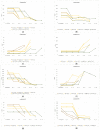Genome-Wide Association Analysis of Senescence-Related Traits in Maize
- PMID: 36555534
- PMCID: PMC9782587
- DOI: 10.3390/ijms232415897
Genome-Wide Association Analysis of Senescence-Related Traits in Maize
Abstract
Senescence is a programmed process that involves the destruction of the photosynthesis apparatus and the relocation of nutrients to the grain. Identifying senescence-associated genes is essential to adapting varieties for the duration of the cultivation cycle. A genome-wide association study (GWAS) was performed using 400 inbred maize lines with 156,164 SNPs to study the genetic architecture of senescence-related traits and their relationship with agronomic traits. We estimated the timing of senescence to be 45 days after anthesis in the whole plant and specifically in the husks. A list of genes identified in a previous RNAseq experiment as involved in senescence (core senescence genes) was used to propose candidate genes in the vicinity of the significant SNPs. Forty-six QTLs of moderate to high effect were found for senescence traits, including specific QTLs for husk senescence. The allele that delayed senescence primarily increased grain yield and moisture. Seven and one significant SNPs were found in the coding and promoter regions of eight core senescence genes, respectively. These genes could be potential candidates for generating a new variation by genome editing for functional analysis and breeding purposes, particularly Zm00001d014796, which could be responsible for a QTL of senescence found in multiple studies.
Keywords: QTL; candidate gene; genome-wide association study (GWAS); maize; senescence.
Conflict of interest statement
The authors declare no conflict of interest.
Figures





References
-
- Tollenaar M., Daynard T.B. Leaf Senescence in Short-Season Maize Hybrids. Can. J. Plant. Sci. 1978;58:869–874. doi: 10.4141/cjps78-126. - DOI
-
- Wolfe D.W., Henderson D.W., Hsiao T.C., Alvino A. Interactive Water and Nitrogen Effects on Senescence of Maize. II. Photosynthetic Decline and Longevity of Individual Leaves. Agron. J. 1988;80:865–870. doi: 10.2134/agronj1988.00021962008000060005x. - DOI
-
- Fujita K., Sato H., Sawada O., Sendo S. Husk Leaves Contribution to Dry Matter and Grain Production as Well as n Distribution in Flint Corn (Zea mays L.) Genotypes Differing in Husk Leaf Area. Soil Sci. Plant Nutr. 1995;41:587–596. doi: 10.1080/00380768.1995.10419620. - DOI
MeSH terms
Grants and funding
LinkOut - more resources
Full Text Sources

